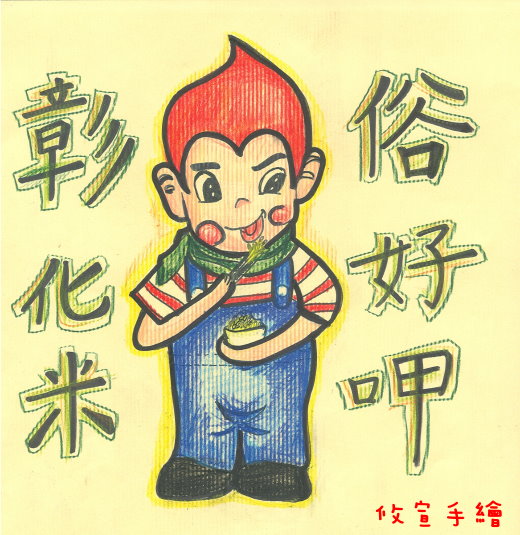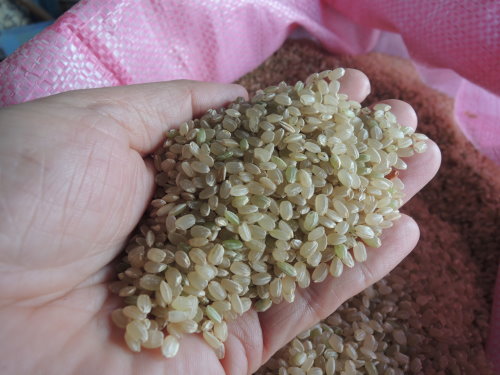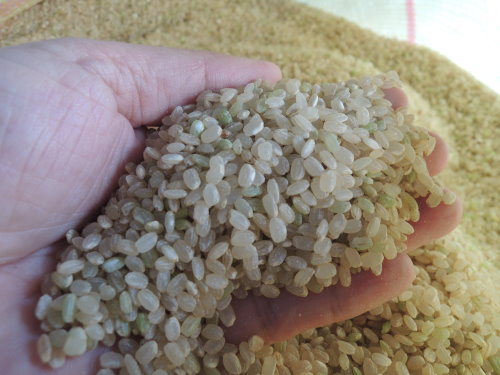|
Home
›››
Love for Grains
›››
getting to know the rice milling process
Each grain is hard to come by—
getting to know the rice milling process
The harvested paddy rice from the field,
after the husks are removed they become brown rice.
The brown rice with its bran removed and germ remaining is a semi polished
rice.
After the germ and husk are removed the endosperm left is white rice.

The Rice Castle in Pitou Township has a forty to fifty years old rice
milling machine. It clearly demonstrated the rice milling process of the
pasts. Many people did not know how brown rice became white rice until
they’ve came here.
[Step 1]
The harvested grain must go through the hulling machine to remove the hulls
of the grain. The grain is processed into brown rice and at this point the
rice and hulls are not entirely separated.
 |
 |
|
Unprocessed paddy rice |
The hulling machine uses the blanket cylinder to generate torque to
strip the hulls |
[Step 2]
The bucket elevator is used to elevate the grain to a specific height then
processed. The concept of the bucket elevator is to take advantage of the
precise centrifugal force to dump the rice in the trough onto the sliding
band.

Bucket elevator can save manpower
[Step 3]
he main function of the threshing machine is to use the speed of wind to
separate the hulls and the brown rice. The hulls are lighter in weight and
therefore fall further away, whereas the unpolished rice is heavier and
falls closer. The hulls are also called husks and are commonly used as
fertilizer.
 |
 |
|
The threshing machine separated the husks from the brown rice. |
The brown rice and the stripped husks |
[Step 4]
The rice polishing machine uses the propeller within to make the brown rice
tumble and rub against each other hence strip the bran off the rice. Then
the holes in the net are used to separate the rice from the bran and the
brown rice is refined into white rice.
The bran is high in nutritious value and also is rich in vitamins
B1, B2, protein and fat. It can help enhance human digestive and nerve
system. Therefore, many people grind it into bran powder and there were also
farmers who use them as animal feed.
 |
 |
|
Brown rice became white rice after being processed by the rice
polishing machine. |
Bran (Left) also high in nutritious value |
[Step 5]
The stone picker uses the power of wind to make the rice jump and the bumpy
net screen cause friction. The white polished rice had little friction and
would move downward whereas the stone is edgy and cause more friction hence
move upward. Lastly, the stones are picked out from the rice. The elders
used to say that one could lose teeth from eating rice. Well, with the stone
picker we will no longer eat rice with stone in it.

After the invention of the stone picker we no longer lose our teeth when
eating rice.
[Step 6]
The color sorter machine was a later invention. The rice chute within the
machine is equipped with a color sorting camera which when the color sorting
needle detects foreign objects the camera would send a message to the
machine computer and the computer would send a command to the air gun to
shoot off the alien object. This way flawed rice and foreign particles may
be excluded.
After the last process each grain of rice is perfect in form and quality.
 |
 |
|
The rice we eat now is all selected by the computer |
Rice eliminated by the computer |
After all this, you must have noticed that there were only brown rice and
white rice in the past and no semi-processed rice. Actually, through the
refining process the rice with the highest nutrition value is brown rice and
not white rice. Due to the fact that brown rice has husks remaining and is
hard to cook and chew the semi-polished rice is later developed. Unlike
white rice which removes all the germ of the rice, the semi-polished rice
kept the germ at the top of the rice which makes it more nutritious and
superior in texture as well.
 |
 |
|
Brown rice is darker in color and has a glow to its surface |
Semi-processed rice is whiter in color and has a dull surface |
[Remarks]
Nutrition Value per r100g Brown rice, semi-polished rice, and white rice:
| |
Brown rice |
Semi-polished rice |
White rice |
|
Calories(kcal) |
351 |
354 |
356 |
|
Protein(g) |
7.9 |
7.5 |
6.6 |
|
Fat(g) |
1.9 |
1.4 |
0.5 |
|
Carbohydrate(g) |
71.8 |
74.4 |
75.7 |
|
Fiber(g) |
1.0 |
0.4 |
0.12 |
|
Vitamin B1(mg) |
0.54 |
0.3 |
0.12 |
|
The protein and fat data were from the Central Region Branch,
the remaining data were from the book “The Science of Rice
Cooking” published by the Fuxing History Conservation Branch |
|
Source: Central Region Branch, Agriculture and Food Agency,
Council of Agriculture |
In the early period where food was scarce, a meal of white rice was a luxury
to the common household. Through the change of time, the modern people
became more health conscious, hence brown rice and semi-polished rice became
the representative of a healthy eating alternative. In reality, brown rice,
semi-processed rice or white rice are all the products of processed paddy
rice. They are the fruit of the hard works of the famers. Through planting,
harvesting, and steps of processing the paddy rice became the rice we eat at
our table. Each grain is obtained with great difficulty.
[References]
Rice Castle, Central Region Branch, Agriculture and Food Agency, Council of
Agriculture
[Photos]
Taken by Grain Head Team
 |